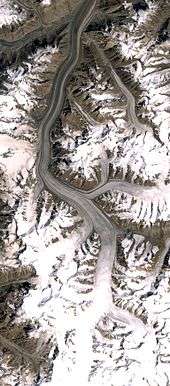glaciology
English
WOTD – 8 December 2017
Etymology

A Landsat 7 satellite image of the Fedchenko Glacier in Tajikistan. At a length of 77 kilometres (48 miles), it is the longest glacier not in a polar region.
From Latin glaciēs (“ice”) (from Proto-Indo-European *gel- (“to be cold; to freeze”)) + -ology (“study of a particular subject”).[1]
Pronunciation
- (Received Pronunciation) IPA(key): /ˌɡleɪsɪˈɒlədʒi/
- (General American) IPA(key): /ˌɡleɪʃiˈɑlədʒi/
- Hyphenation: gla‧ci‧o‧lo‧gy
Noun
glaciology (countable and uncountable, plural glaciologies)
- (geography) The study of ice and its effect on the landscape, especially the study of glaciers. [from late 19th c.]
- 1856, W. S.-Y., “Greenland”, in Thomas Stewart Traill, editor, The Encyclopædia Britannica, or Dictionary of Arts, Sciences, and General Literature, volume XI, 8th edition, Edinburgh: Adam and Charles Black, OCLC 162676963, page 40, column 2:
- From this high position in latitude, explorations (furthered for a time by the effective aid of their Esquimaux dogs) were perseveringly made, and rewarded by results of the most interesting nature in geography, hydrography, and glaciology.
- 1989, L. A. Rasmussen, “Discussion”, in Surface Velocity Variations of the Lower Part of Columbia Glacier, Alaska, 1977–1981 (U.S. Geological Survey Professional Paper; 1258-H), Washington, D.C.: United States Government Printing Office, OCLC 165507411, page H28:
- Until now, aerial photography had been used in glaciology only for mapping the glacier surface and the surface velocity field; other, much more expensive, methods have been used to determine the bed and mass balance.
- 1975, J[ohn] T. Andrews, Glacial Systems: An Approach to Glaciers and Their Environments (Environmental Systems), North Scituate, Mass.: Duxbury Press, OCLC 1323894, page 56:
- This general approach offers the possibility of reconstructing past glaciologies for a situation where (1) the outline of the glacier can be reconstructed, (2) the ELA [equilibrium line altitude] can be determined, (3) the area under the ELA can be measured, and (4) there is some information on the winter balance and ablation gradient of the former glacier.
- 1999, Peter J. Robinson; Ann Henderson-Sellers, “Moisture in the Atmosphere”, in Contemporary Climatology, 2nd edition, Abingdon, Oxon.; New York, N.Y.: Routledge, published 2014, →ISBN, page 56:
- In order to understand and predict the actions of water in the climate system it is useful to think of the water as being part of a distinct system, sometimes called the hydrological cycle […]. A complete understanding of this system would […] require excursions into geomorphology, pedology, botany, glaciology, oceanography and, if human structures are included as part of the Earth's surface, civil engineering.
- 2003, Adam Johnson, chapter 5, in Parasites Like Us, New York, N.Y.: Viking Books, →ISBN; republished London: Black Swan, 2014, →ISBN, page 152:
- I was leafing through deep-core glaciology results from Greenland's mid-rift when the telephone rang. It droned on forever before it finally quit and I could concentrate again. The Greenland data confirmed all the other studies: the earth suffered ninety thousand years of ice-age weather, then ten thousand years of warm, in a loop that repeated over and over, as far back as there was ice to record it.
-
Derived terms
Translations
study of ice and its effect on the landscape
|
|
References
- “glaciology” (US) / “glaciology” (UK) in Oxford Dictionaries, Oxford University Press.
Further reading

- “glaciology” in Merriam–Webster Online Dictionary.
This article is issued from
Wiktionary.
The text is licensed under Creative
Commons - Attribution - Sharealike.
Additional terms may apply for the media files.